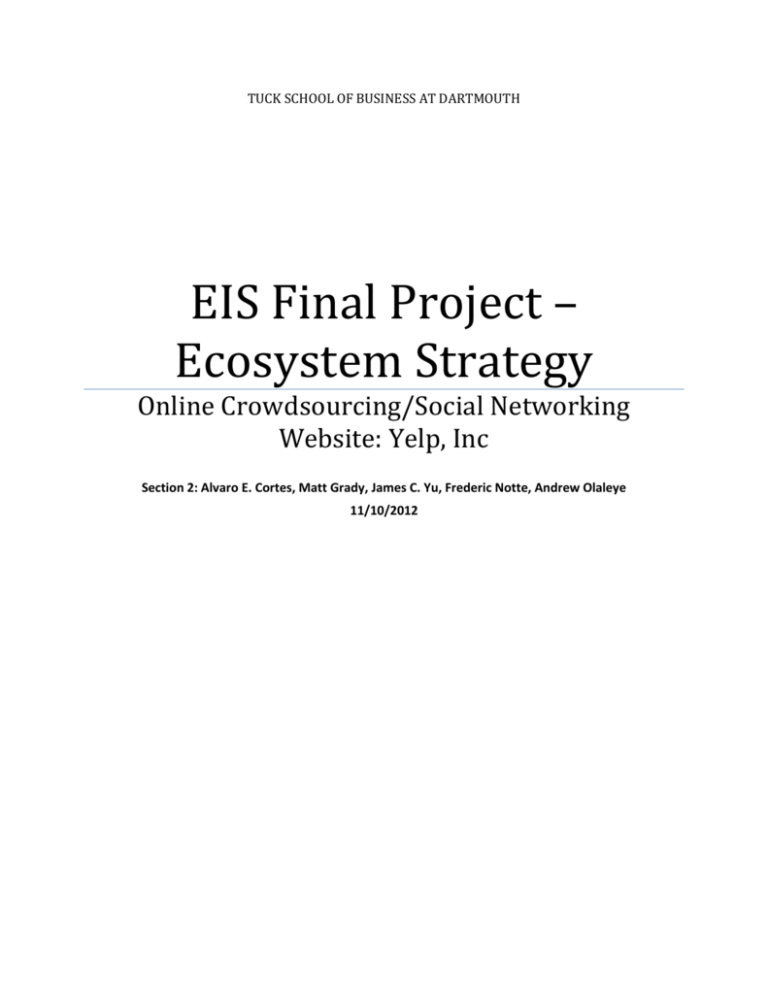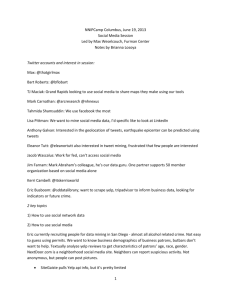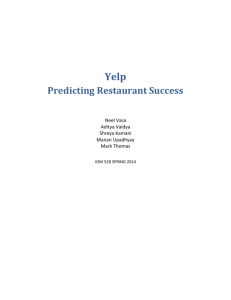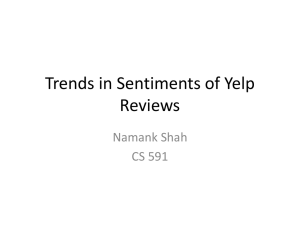EIS Final Project – Ecosystem Strategy
advertisement

TUCK SCHOOL OF BUSINESS AT DARTMOUTH EIS Final Project – Ecosystem Strategy Online Crowdsourcing/Social Networking Website: Yelp, Inc Section 2: Alvaro E. Cortes, Matt Grady, James C. Yu, Frederic Notte, Andrew Olaleye 11/10/2012 The history of the local search industry is long and boring. For centuries, consumers in local areas have relied on each other for advice regarding the best places to shop, eat, and purchase other valuable goods and services. “Search” knowledge resided with specific people who had significant life experience in a local area, whose knowledge of and experience with a range of local businesses could be passed on to others via word of mouth. The publication of the first Yellow Pages directory of local businesses in 1883 represented a significant innovation for the local search industry. With widespread distribution of the new, comprehensive directory, consumers no longer needed to rely on knowledgeable locals (or their own experience) to find the businesses that offered the goods and services they needed. However, recommendations on which businesses were preferable (read, the “best” providers of such goods and services) were still conveyed by word of mouth. Such recommendations were often unreliable since they represented the subjective point of view and anecdotal experiences of the person making the recommendation. In some large US consumption markets, recommendation services emerged to help address the latter problem. For example, travel guides produced by travel review companies published recommendations of sites to visit and restaurants to patronize. Zagat’s and other restaurant review services paid experts to sample food offerings and write reviews on a wide range of dining options in a local area. However, such recommendations were offered only for a fee (via the purchase of a publication) and generally only catered to niche markets (e.g., out-of-town travelers or high-end food consumers). The local search industry began to change in the mid-1990s with the advent of the internet and its widespread use by consumers. At this time, all existing local search publications were digitized (including the Yellow Pages, travel guides, Zagat guides, and other similar offerings) and made accessible online. Moreover, several search engines entered the local search market, offering the ability to search for multiple business listings quickly within a specified geographic area (usually defined by a zip code or city name). Yet while search was available to consumers for free via sites like Google, Yahoo!, and Bing, recommendations and advice regarding local businesses still needed to be purchased and were only available for a small range of businesses within a given geographic area. Enter Yelp. In 2004, Yelp, Inc. was founded in San Francisco by Jeremy Stoppelman, the current CEO and former PayPal software engineer, and David Galbraith. The website, yelp.com, is an online crowdsourcing platform, essentially gathering information from members of the public to create a more substantial body of information than one may have gathered on his/her own. The yelp platform currently features more than 22 million business reviews, approximately 61 million unique visitors per month, and more than 5 million unique mobile devices (data as of September 20, 2011). Traditional online crowdsourcing sites, such as Citysearch and Yahoo Local, allow consumers to leave reviews for restaurants and other businesses. However, yelp.com goes a step further. Mr. Stoppelman and company came up with an ingenious idea, which is to make online crowdsourcing fun and interactive through social networking. Many people are naturally curious about what businesses are new, popular, affordable, reliable, trustworthy, etc. Yelp.com created a social networking community that gave a voice to consumers essentially bringing “word of mouth” online. The online crowdsourcing/social networking website allowed friends to solicit and receive recommendations from each other regarding a wide range of businesses, from dry cleaners, to doctors, to restaurants and hotels. The site also allowed users to post unsolicited recommendations and reviews on local businesses, which proved to be very popular with users. Soon after launch, Yelp’s website boasted thousands of reviews of local businesses, most of which were posted by repeat contributors. The company also developed and implemented an algorithm that screened contributors’ reviews of businesses and removed those that were of questionable quality. Anyone with an internet connection could access the yelp website and browse ratings and reviews for a multitude of businesses. The three main actors in Yelp’s ecosystem are the contributors who write reviews, consumers1 who use reviews to make buying decisions, and the local businesses for which reviews are written2. The experience for consumers is user-friendly. A consumer opens yelp.com on their web browser and the site recognizes the nearest major city or town in which he/she is located. The consumer is then able to search for whatever type of business he/she would like to know more about. Once the consumer clicks on a particular business, Yelp then displays both the details of the business and the reviews associated with it. Exhibit #1: Screen shot of a restaurant in Sherman Oaks, California 1 Consumers will later be nominated “Searchers” as to clarify the consumption we will be referring to in the Leadership Prism. Indeed, the real consumers for Yelp.com are the paying local businesses and advertisers but for now, we can think of the consumers as the people that consume information and local businesses services. 2 While not useful to mention at this point, a fourth one will be used later on: the Advertisers. To become a contributor, one must create a user profile, which requires your first and last name, zip code, password for logging in, and a valid email address. Once signed in, one may begin to both write reviews and rate businesses. There are a number of different features that contributors can use, all of which are in place to enhance the experience and make it fun. Users maintain a profile page on the yelp platform, which is used as a reputation mechanism. An integral aspect of Yelp’s business is to build loyalty among contributors, and it does so through incentives. Yelp has created the “Yelp Elite Squad,” which is a way of recognizing and rewarding contributors who are active and trustworthy. The Elite label is based on a multitude of things, including authoring well-written reviews, active voting and complementing, strong profile page, and working well with other members of the community. In addition, Yelp employs a community manager to monitor and connect the best contributors, “Yelp Elite Squad”, in a network. Yelp has invested a large amount of capital and resources in the design and management of the platform. The reputation system is well suited to one of its major business goals of encouraging participation and quality contributions. The last main actors are local businesses and advertisers, who are incentivized to participate as the consumer/user-base increases. Local businesses can create a free account on Yelp that provides additional information such as service hours, history and/or pictures. Local businesses can also pay for premium services to promote themselves thorough targeted search advertising and other enhancements. Exhibit #2: Screen shot of dashboard for local business Yelp generates revenue in three ways: 1) local advertising (71% of revenue in 2010), 2) brand advertising (25% of revenue in 2010), 3) other services, including Yelp deals and partner arrangements (4% of revenue in 2010). The basic idea, which will be discussed in greater detail below, is for Yelp to create a large community of yelp users which would, in theory, encourage local businesses and brands to advertise, essentially passing along surplus in the form of compensation. Thus far, Yelp has done just that in a unique and innovative way. Value Blueprint A significant amount of infrastructure and technology was required for Yelp’s value proposition to ensue – e.g. the internet, internet service providers, mass production and distribution of personal computers, widespread internet access, etc. The fact that these were all in place and functioning quite well at the time of Yelp’s emergence garnered a green light. Yelp’s business model depends on four major actors3: contributors, searchers, local businesses and advertisers (Exhibit 3). It relies on contributors to write reviews on local businesses. It needs searchers to come to Yelp’s website to look at these reviews and generate traffic. It needs local businesses and advertisers to pay for ads to generate revenue. For the businesses to be willing to spend ads dollars, Yelp will first need to generate enough traffic from customers. Therefore, Yelp will first need to make sure the contributors and searchers are onboard with the service. Exhibit 3: Yelp’s Value Blue Print However, if we use the value blue print framework to examine the contributors and the searchers’ sides, we can see that Yelp faces some challenges. On the contributor side, Yelp relies on users to generate reviews. However, there are little incentives for people to do so. People want to see reviews but they do not want to waste time and efforts to write the reviews themselves. Moreover, Yelp needs to make sure the reviews people post are helpful for searchers. People who write reviews are often the ones who have either fantastic or horrible experiences. If all the reviews are of such extremes, they do not help searchers to judge the quality of local business. So, Yelp will need to overcome both 3 While not useful to mention at this point, a fourth one will be used later on: the Advertisers. the incentive and quality challenges on the contributor side. And it is hard to see why people want to make the efforts to write useful review at this point. So, the contributor side has a yellow light at best in the beginning (Exhibit 4). Exhibit 4: Contributors and searchers had yellow lights for value blue print in the beginning Searchers Contributors Time and efforts to write reviews No incentives “Extreme” reviewers more likely Credibility issues Competitor offerings from Zagat, Citysearch and Yahoo Local As for the searchers’ side, Yelp needs to generate enough value to attract searchers to its website. At the time, there were already several competitors’ offerings. For example, Zagat provided professional reviews on restaurants in a booklet format. Citysearch and Yahoo Local were dominant providers of online reviews. Given these alternatives, it is not clear if searchers will be attracted to Yelp’s online reviews. Moreover, Yelp uses a user-generated content model. It may be hard to overcome the credibility issue that its reviews are as trustworthy as those of Zagat. Therefore, it also has a yellow light on the consumer front. The way Yelp turned these two yellow lights to green was by focusing on attracting high-quality contributors. Jeremy Stoppelman who is the CEO of Yelp explains, “Yelp is about the reviewing experience.”4 The challenge for user generated reviews is that people are not incentivized to do reviews. 4 Claire Miller, “A More Local, Social Citysearch,” 2009, http://bits.blogs.nytimes.com/2009/03/19/a-more-local-social-citysearch/ Yelp attracts contributors by providing them social benefits for writing reviews. Contributors build their profile pages on Yelp. They write reviews and this helps them to get connected to other like-minded people in Yelp. Their reviews are shown on their profile pages and they can display on their profile page how many people find their reviews helpful. Tying the quality of the contributors review to their own profile page helps create a sense of pride for the contributors. Moreover, it also helps ensure quality of the reviews. Nobody wants to be viewed that their reviews are not good. As an added incentive, Yelp created the “Yelp Elite Squad” status for the best contributors. If contributors receive certain amount of useful rating, they will become an elite member. Elite members get invited to cool parties organized by Yelp or get invited to restaurants. Providing proper incentives for contributors differentiates Yelp from its other online competitors. Yahoo Local and Citysearch at the time only allowed anonymous reviews. So, reviewers received no recognition for their work. As a result, reviewers are much more productive at Yelp. About 27.1% of contributors write more than 20 reviews while only 0.6% at Citysearch and 1.9% at Yahoo Local5. Having a loyal base of online contributors helps Yelp generate high quality reviews that are not matched by other online websites. To establish itself as a clear first choice for searchers, Yelp differentiates itself from Zagat in the following ways: Yelp is an online platform while Zagat is in a paper format. Its online presence enables Yelp to reach more searchers than Zagat. Moreover, Yelp’s reviews have a richer content. Unlike Zagat which provides one professional view on a restaurant, Yelp provides a rating combined with different perspectives from different users. This richness of information provides searchers additional data points (eg. names of some good dishes in this restaurant). Yelp also tries to distinguish itself from other online crowdsourcing sites through its quality of reviews. The issue for online reviews is that they can be biased. Businesses often try to ask friends and 5 Zhongmin Wang, The B.E. Journal of Economic Analysis & Policy, Manuscript 2523, “Anonymity, Social Image, and the Competition for Volunteers: A Case Study of the Online Market for Reviews”, April 2010 families to create reviews that are favorable to them. Yelp has proprietary software that tries to filter out this kind of biased reviews. The software works by putting more weight on contributors who have contributed many times at Yelp before. First-time contributors are the ones who are more likely to be influenced by local business. Moreover, first-timers are more likely to rate business very highly or poorly, thus making the reviews less helpful. Citysearch and Yahoo Local could not imitate Yelp because most of its contributors are not frequent contributors. Yelp was able to address the challenges facing the contributors and searchers and turned the lights from yellow to green. The Yelp platform gained traction as more contributors joined because of the social benefits. And more searchers joined because of better and more comprehensive reviews. With the high number of traffic on its website, Yelp was able to get local businesses to put ads on its website. Leadership Prism As we consider the overall value proposition that Yelp has been trying to put in place, we cannot refrain from trying to confirm what our initial intuition tells us on what in the Yelp model makes it more successful that Yahoo Local, Citysearch or Zagat. To better understand how Yelp acted on the ecosystem, we observed the situation through yet another paradigm. The Leadership Prism will make us understand the key differences between the Yelp model and its predecessors and current competitors. We have been covering it at length during our study of the Value Blueprint: apart from the situational actors that made the online search possible at a large scale (Personal Computers, Internet services providers, capable mobile devices,...), there are four main actors (or partners) that need to adhere energetically to the overall system in order for it to produce the suggested value: the contributors, the searchers, the local businesses and the advertisers. In order for the value to be optimized and correctly delivered, each of these partners needs to receive a positive surplus. Today, at inception on Day 1, Yelp Value Proposition’s Leadership Prism resembles that of Yahoo Local and Citysearch: Exhibit 5: Day 1 – Yelp Leadership Prism Searchers link to the website and search for positively-evaluated businesses in their area of interest. Their relative benefits are linked to the overall quality of the evaluations system and their costs are negligible. Overall, their surplus is positive. Contributors post on the website, building up the database of evaluations and presence of local businesses. Their evaluations are of fairly different quality. Extremely bad or good evaluations are typical as the contributors need to find value for themselves in the process either by feeling better after having “complained” about a bad experience or by feeling so good about the service they received that they think they can legitimately make the local business benefit from their own experience value surplus. As we observe the Leadership Prism for a standard crowdsourcing company, the contributors are the main source of information and value for the network. Yet, this partner is the only one that is not specifically compensated for his contribution to the aggregated information. Lastly, local businesses and advertiser’s surpluses are highly dependent on the size and quality of the searching population that wander on the website. In our example, Yelp benefits from the basic profitability equation subtracting costs from its revenue streams, most of which comes from either local businesses or advertisers, the remainder being created through transaction revenues from partnership arrangements. As one can see, the crucial partners in the ecosystem are the Contributors. Yelp’s strategy didn’t initially account for this fact as it created its platform in 2005. Yelp strategy has been to establish a new crowdsourcing platform in the San Francisco area that would be more fun and socially oriented than the existing ones. In this way, Yelp realized that the very presence of their social network capabilities was precisely why the contributors were posting quality evaluations without compensation, and at a much higher rate than their direct competitors. Therefore, Yelp modified the value distribution and to overly target the contributors’ surplus. Exhibit 6: Day 2 – Yelp Leadership Prism Yelp created a highly developed social network that was primarily aimed at compensating the quality and quantity of the contributors’ interventions through a recognized “social hierarchy” - the elite system – and by extending parties invitations, restaurants tickets and other perks to the best of them. A sense of pride, amongst other material gifts, was the new source of the relative benefits contributors were enjoying on Yelp. Yelp’s strategy is to create a highly valuable network for contributors, even if in the short run, it runs the risk of not being profitable. Yelp will incur the extra expenses as it knows that contributors are the primary source of the quality of their evaluations offering. Exhibit 7: Future Days – Yelp Leadership Prism Positioning Yelp as the highest quality evaluations system – and fun – will yield extra value for searchers, increasing their own surplus. As the searchers base expands, local businesses and advertisers will be able to reach a larger pool of potential customers to try their services and be present on the primary online crowdsourcing / social networking platform of its kind. Yelp believes that the large scale of its base will yield the company’s surplus as the network expands in the future. In sum, Yelp was able to align the interests of multiple constituencies in order to implement its innovative business model rather quickly. After less than two years in operation, Yelp boasted over 1 million unique visitors per month on its website. As indicated in our ecosystem map above, most of the ecosystem was receptive to Yelp’s innovation at the time of launch. Additionally, co-innovation risk and adoption-chain risk were both low. All technologies required to deliver Yelp’s value proposition were already in place and commercialized and, as a result, Yelp could deliver its product directly to customers. As such, it also did not face any adoption-chain risk. Moreover, their unique social-networking-based model overcame the one significant barrier to adoption that still existed in the ecosystem: getting contributors to write quality reviews for free. In order for Yelp’s value proposition to be fully delivered to consumers, the company needed to be able to offer quality reviews of business across a wide range of sectors and types. As such, it needed to build a critical mass of contributors to develop content for its site before it had attracted many visitors to its website. And Yelp needed to accomplish this by creating an incentive for contributors to do so other than direct financial compensation. And as described above, Yelp’s unique approach successfully overcame this hurdle. As quality content proliferated on the company’s site, Yelp pages appeared more frequently in Google searches for information on local businesses and consumer traffic on the site grew. And as consumer traffic grew, Yelp was then able to attract advertising dollars from a larger and larger pool of local businesses looking to take advantage of the growing volume of high-quality leads available on yelp.com. In 2012, the company continued to benefit from significant growth in contributor reviews (+49% year-over-year in 3Q12), consumer visitors (+37% year-over-year in 3Q12) and paying local business accounts (+82% year-over-year in 3Q12). However, interestingly, Yelp is still an unprofitable business. A significant portion of the company’s operating losses is surely driven by the company’s rapid expansion into new markets around the world (note: the company operates in 96 global markets today, 43 of which are international), for which the company is currently incurring cost but is not yet generating revenue. Additionally, the company’s recent IPO has sparked a rapid increase in stock-based compensation, which has reduced earnings. Yet part of the poor profitability, despite the company’s already-global scale, is that its model is not easily scalable. Indeed, it needs to employ a large sales force in each of its local markets to get businesses signed up as advertisers. Part of the issue here is that the company is seeing to provide detailed information regarding thousands of local businesses, so the model is inherently micro in scale. But another issue is that local businesses already have a number of means of advertising to its potential customers – newspaper, TV, radio, their own websites, signage and billboards, etc. They can also advertise on a search engine directly rather than on Yelp, where many consumers end up after searching more generically on a search engine. In short, while Yelp provides local businesses with attractive leads, so do a number of other advertising partners and media. Yelp’s value proposition / surplus for local businesses, then, does not yet appear to be robust enough to generate sizable enough ad revenues to cover its costs in managing the Yelp site that, otherwise, provides an excellent value / surplus to consumers and content contributors. In order for Yelp to get over this last hurdle and become not only a large company but a profitable company, it may well need to tweak its model so that businesses simply cannot live without partnering with Yelp.






